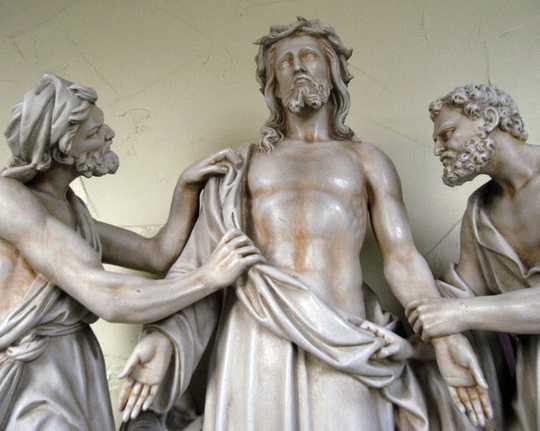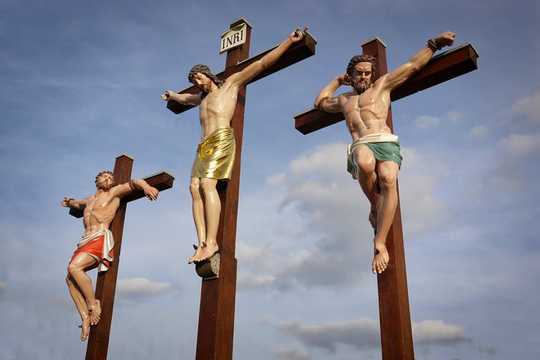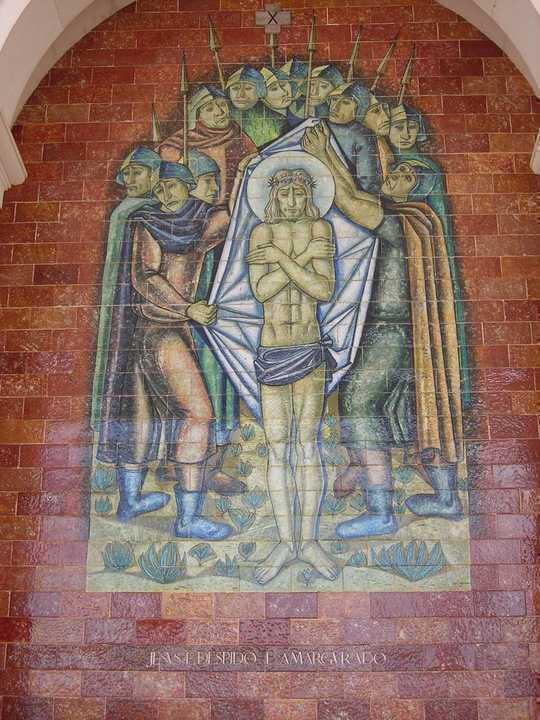 The tenth station of the cross: the stripping of Jesus. elycefeliz / Flickr, CC BY-NC-ND
The tenth station of the cross: the stripping of Jesus. elycefeliz / Flickr, CC BY-NC-ND
The disturbing story of the torture and crucifixion of Jesus of Nazareth as described in the New Testament is one of the most widely known and often retold stories in human history. Yet despite being read and remembered so often, there is a part of the story which typically receives little attention and minimal discussion – the stripping of Jesus.
The #MeToo movement has highlighted the prevalence of sexual assault, sexual harassment and other sexual abuses experienced by women and girls in many different forms. It has also exposed the common tendency to deny, dismiss, or minimise the significance and impact of these experiences.
The stripping of Jesus
With this in mind, it seems especially appropriate to recall the stripping of Jesus – and to name it for what it was intended to be: a powerful display of humiliation and gender-based violence, which should be acknowledged as an act of sexual violence and abuse.
The idea that Jesus himself experienced sexual abuse may seem strange or shocking at first, but crucifixion was a “supreme punishment” and the stripping and exposure of victims was not an accidental or incidental element. It was a deliberate action that the Romans used to humiliate and degrade those they wished to punish. It meant that the crucifixion was more than just physical, it was also a devastating emotional and psychological punishment.
The convention in Christian art of covering Christ’s nakedness on the cross with a loincloth is perhaps an understandable response to the intended indignity of Roman crucifixion. But this should not prevent us from recognising that the historical reality would have been very different.
 The convention in Christian art is to cover Christ’s nakedness on the cross with a loincloth. fietzfotos/pixabay
The convention in Christian art is to cover Christ’s nakedness on the cross with a loincloth. fietzfotos/pixabay
This is not just a matter of correcting the historical record. If Jesus is named as a victim of sexual abuse it could make a huge difference to how the churches engage with movements like #MeToo, and how they promote change in wider society. This could contribute significantly to positive change in many countries, and especially in societies where the majority of people identify as Christian.
Some sceptics might respond that stripping a prisoner might be a form of violence or abuse, but it is misleading to call this “sexual violence” or “sexual abuse”. Yet if the purpose was to humiliate the captive and expose him to mockery by others, and if the stripping is done against his will and as a way to shame him in public, then recognising it as a form of sexual violence or sexual abuse seems entirely justified. The way that the stripping of Vercingetorix, King of the Arverni, is depicted in the first episode of the first series of the HBO series Rome is an example of this.
{vembed Y=Xkl5ovfANO8}
The scene highlights the vulnerability of the naked prisoner who is stripped and exposed in front of the assembled ranks of hostile Roman soldiers. The power and control of Roman power is contrasted with the vulnerability and forced submission of the prisoner. The scene also hints at the possibility of even greater sexualised violence which might be in store.
 The Station of the Cross in Santuario de Fatima Jul, Portugal. Wikimedia Commons
The Station of the Cross in Santuario de Fatima Jul, Portugal. Wikimedia Commons
Combating Stigma
Jesus’ gender is central to readers’ seeming unwillingness to recognise the sexual abuse to which he is subjected. Analysis of the gendering of nakedness by Margaret R. Miles demonstrates that we view male and female nakedness differently. In biblical art in the Christian West, Miles argues that the naked male body represents glorious athleticism representing spiritual as well as physical suffering.
Sexual abuse doesn’t form part of the narrative of masculinity inherent in representations of Jesus. Naked women, however, are immediately identified as sexual objects. Seeing a woman being forcibly stripped, then, might be more recognisable as sexual abuse than the stripping of Jesus in the Gospels of Matthew and Mark. If Christ was a female figure we wouldn’t hesitate to recognise her ordeal as sexual abuse.
Some present day Christians are still reluctant to accept that Jesus was a victim of sexual violence and seem to consider sexual abuse as an exclusively female experience.
BOOK NOW for our special lecture with @UniShefSIIBS Visiting Professor @TombsDavid ‘#MeToo Jesus: Why Naming Jesus as a Victim of Sexual Abuse Matter’, Weds 16 Jan, G.03 Jessop West https://t.co/VBqUiPzSOS
— The Shiloh Project (@ProjShiloh) December 18, 2017
We may not want to dwell on the disturbing indignity of crucifixion for the whole year, but it is not right to forget about it completely either. The sexual abuse of Jesus is a missing part of Passion and Easter story retellings. It’s appropriate to recognise Jesus as a victim of sexual violence to address the continuing stigma for those who’ve experienced sexual abuse, especially men.
Lent offers a period in which this stark reality of crucifixion might be recalled and connected to the important questions that movements like #MeToo are raising for the churches and for wider society. Once we acknowledge the sexual abuse of Jesus perhaps we’ll be more willing to acknowledge sexual abuse in our own contexts.![]()
About the Authors
Katie Edwards, Director SIIBS, University of Sheffield and David Tombs, Howard Paterson Chair of Theology and Public Issues, University of Otago
This article is republished from The Conversation under a Creative Commons license. Read the original article.

Related Books:
Prayer Journal for Women: 52 Week Scripture, Devotional & Guided Prayer Journal
by Shannon Roberts and Paige Tate & Co.
This book offers a guided prayer journal for women, with weekly scripture readings, devotional prompts, and prayer prompts.
Click for more info or to order
Get Out of Your Head: Stopping the Spiral of Toxic Thoughts
by Jennie Allen
This book offers insights and strategies for overcoming negative and toxic thoughts, drawing on biblical principles and personal experiences.
Click for more info or to order
The Bible in 52 Weeks: A Yearlong Bible Study for Women
by Dr. Kimberly D. Moore
This book offers a yearlong Bible study program for women, with weekly readings and reflections, study questions, and prayer prompts.
Click for more info or to order
The Ruthless Elimination of Hurry: How to Stay Emotionally Healthy and Spiritually Alive in the Chaos of the Modern World
by John Mark Comer
This book offers insights and strategies for finding peace and purpose in a busy and chaotic world, drawing on Christian principles and practices.
Click for more info or to order
The Book of Enoch
translated by R.H. Charles
This book offers a new translation of an ancient religious text that was excluded from the Bible, offering insights into the beliefs and practices of early Jewish and Christian communities.






















